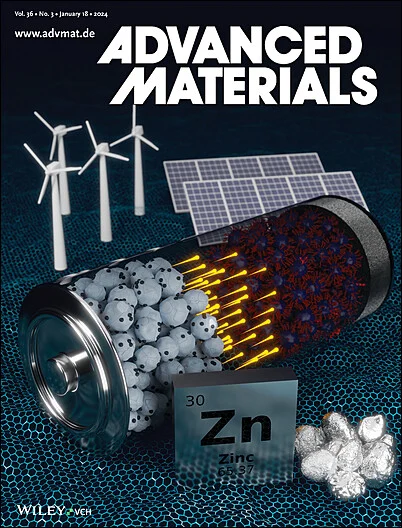Photoinduced Cleavage of Respiratory Syncytial Virus by Chiral Vanadium Trioxide Nanoparticles
IF 27.4
1区 材料科学
Q1 CHEMISTRY, MULTIDISCIPLINARY
引用次数: 0
Abstract
Respiratory syncytial virus (RSV) poses a significant threat to the health of infants, children, and the elderly, and as of now there is a lack of effective therapeutic drugs. To tackle this challenge, chiral vanadium trioxide nanoparticles (V2O3 NPs) with a particle size of 2.56 ± 0.34 nm are successfully synthesized, exhibiting a g-factor value of 0.048 at 874 nm in terms of circular dichroism. Under 808 nm light irradiation, these chiral V2O3 NPs demonstrated selective cleavage of the RSV pre-fusion protein (RSV protein), effectively blocking its conformational rearrangement and preventing RSV infection both in vitro and in vivo. Experimental analysis revealed that the chiral V2O3 NPs specifically bind to the functional domain spanning from aspartate200 (D200) to asparagine208 (N208) in the primary sequence of the RSV protein. Notably, L-V2O3 NPs exhibited a higher affinity, which is 4.06 times that of D-V2O3 NPs and 13.55 times that of DL-V2O3 NPs. The precise cutting site is located between amino acid residues leucine204 (L204) and proline205 (P205), attributed to the reactive oxygen species (ROS) generated by photoinduced nanoparticles. In addition, L-V2O3 NPs inhibited RSV infection by 99.6% in nasal epithelial cells and 99.2% in Vero cells. In the RSV-infected mouse model, intranasal administration of L-V₂O₃ NPs effectively controlled the viral load in the lungs of mice, reducing it by 92.43%. The hematoxylin and eosin staining of mouse organs and serum biochemical indicators are similar to those of the wild-type group, indicating the biosafety of L-V₂O₃ NPs. The findings suggest that chiral nanoparticles hold great potential in controlling RSV and provide new directions and ideas for drug development against viruses.

求助全文
约1分钟内获得全文
求助全文
来源期刊

Advanced Materials
工程技术-材料科学:综合
CiteScore
43.00
自引率
4.10%
发文量
2182
审稿时长
2 months
期刊介绍:
Advanced Materials, one of the world's most prestigious journals and the foundation of the Advanced portfolio, is the home of choice for best-in-class materials science for more than 30 years. Following this fast-growing and interdisciplinary field, we are considering and publishing the most important discoveries on any and all materials from materials scientists, chemists, physicists, engineers as well as health and life scientists and bringing you the latest results and trends in modern materials-related research every week.
 求助内容:
求助内容: 应助结果提醒方式:
应助结果提醒方式:


